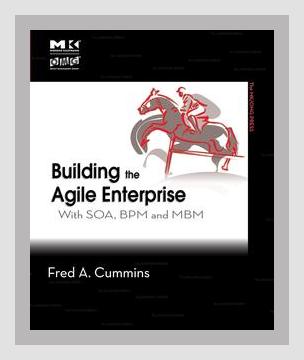Technology and Digital TransformationIT Management
“Building the Agile Enterprise: With SOA, BPM, and MBM” by Fred A. Cummins, published in 2009, is a comprehensive guide that explores how Service-oriented Architecture (SOA), Business Process Management (BPM), and Model-based Management (MBM) can help organizations achieve agility. As IT management becomes increasingly complex, Cummins provides concrete strategies and examples for building flexible, responsive enterprises. Here’s a structured summary of the book highlighting key points, examples, and actionable advice.
1. Introduction to Enterprise Agility
Key Points:
– Agility is defined as the ability of an organization to respond quickly and effectively to changes.
– Traditional organizational structures limit agility due to rigid hierarchies and inflexible processes.
Actionable Advice:
– Assess Current Agility: Evaluate your organization’s current processes, structures, and responsiveness to change.
– Develop an Agility Goal: Set a clear vision of what agility looks like within the context of your organization.
2. Service-Oriented Architecture (SOA)
Key Points:
– SOA is an architectural pattern in which software components (services) can be reused across different applications and processes.
– SOA promotes integration and interoperability by standardizing communication and data exchange.
Examples:
– A retail company uses SOA to integrate various systems, such as inventory management, customer relationship management (CRM), and e-commerce platforms, allowing real-time data sharing and seamless operations.
Actionable Advice:
– Adopt SOA Principles: Begin by identifying reusable services within your IT infrastructure.
– Pilot SOA Projects: Run small, manageable SOA projects to demonstrate value and gain organizational buy-in.
3. Business Process Management (BPM)
Key Points:
– BPM involves designing, implementing, monitoring, and optimizing business processes continuously.
– BPM helps align processes with organizational goals by enhancing transparency and accountability.
Examples:
– An insurance company uses BPM to streamline the claims processing workflow, improving efficiency and customer satisfaction through automated task assignments and real-time monitoring.
Actionable Advice:
– Map Existing Processes: Use BPM tools to document your current processes.
– Identify Process Improvements: Analyze your process maps to find bottlenecks, redundancies, and opportunities for automation.
4. Model-Based Management (MBM)
Key Points:
– MBM involves using models to design, implement, and manage business processes and IT systems.
– Models serve as blueprints that provide a common understanding and guide for changes.
Examples:
– A manufacturing firm employs MBM to simulate different production scenarios, helping them decide the optimal configuration that minimizes waste and maximizes throughput.
Actionable Advice:
– Create Process Models: Develop models for your critical business processes using MBM tools.
– Validate and Iterate Models: Regularly validate these models against real-world performance and refine them as needed.
5. Integrating SOA, BPM, and MBM
Key Points:
– Integrating SOA, BPM, and MBM provides a holistic approach to achieving enterprise agility.
– These methodologies complement each other—SOA standardizes components, BPM manages process flows, and MBM provides the detailed design.
Examples:
– A healthcare provider integrates electronic health records (EHR) using SOA, manages patient workflow with BPM, and uses MBM to ensure compliance and optimize healthcare delivery.
Actionable Advice:
– Develop Integration Strategy: Formulate a strategy that integrates SOA, BPM, and MBM into a cohesive framework.
– Invest in Tools and Training: Ensure your team has access to the right tools and sufficient training to implement these methodologies effectively.
6. Organizational Change Management
Key Points:
– Embracing enterprise agility requires significant organizational change, including shifts in culture and mindset.
– Change management strategies are crucial for successful transitions.
Examples:
– A telecom company adopts a change management program to facilitate the shift towards agile methodologies, involving stakeholder engagement, training programs, and regular communications.
Actionable Advice:
– Establish a Change Management Office: Create a dedicated team to manage the change process and support employees.
– Foster an Agile Culture: Encourage a culture that values flexibility, continuous improvement, and innovation.
7. Governance and Stewardship
Key Points:
– Strong governance frameworks ensure that the agility initiatives align with overall business objectives and compliance requirements.
– Stewardship involves overseeing the proper implementation and ongoing maintenance of agile practices.
Examples:
– A financial institution establishes a governance board to oversee SOA implementations, ensuring that services meet regulatory standards and deliver intended business value.
Actionable Advice:
– Define Governance Policies: Develop policies that guide the implementation and management of SOA, BPM, and MBM.
– Appoint Stewards: Assign stewards responsible for the care and oversight of these practices within their domains.
8. Measuring Success
Key Points:
– Measuring the success of agile initiatives is crucial to demonstrate value and drive continuous improvement.
– Metrics should cover aspects such as process efficiency, cost reduction, and customer satisfaction.
Examples:
– An e-commerce company tracks metrics like order processing time, customer feedback ratings, and operational costs to assess the impact of BPM implementations.
Actionable Advice:
– Develop a Metrics Dashboard: Create a dashboard that captures key performance indicators (KPIs) relevant to your agile initiatives.
– Regularly Review Metrics: Hold regular review meetings to analyze metrics and make informed decisions on further improvements.
9. Case Studies and Real-World Applications
Key Points:
– Real-world case studies provide practical insights into how organizations successfully implement SOA, BPM, and MBM.
– Learning from others’ experiences helps to avoid common pitfalls and accelerates the adoption process.
Examples:
– A government agency uses SOA to integrate disparate systems across departments, improving data sharing and service delivery to citizens.
– A logistics company employs BPM to optimize supply chain operations, resulting in faster delivery times and reduced costs.
Actionable Advice:
– Study Relevant Case Studies: Research case studies within your industry to understand best practices and lessons learned.
– Apply Lessons Learned: Leverage insights from these case studies to inform your implementation strategy.
Conclusion
“Building the Agile Enterprise: With SOA, BPM, and MBM” by Fred A. Cummins offers a thorough exploration of how these methodologies can transform organizations into agile enterprises. The book provides actionable advice and real-world examples to guide practitioners through the process of adopting and integrating SOA, BPM, and MBM. By following Cummins’ guidance, organizations can improve their responsiveness, efficiency, and overall competitiveness in a rapidly changing business environment.
